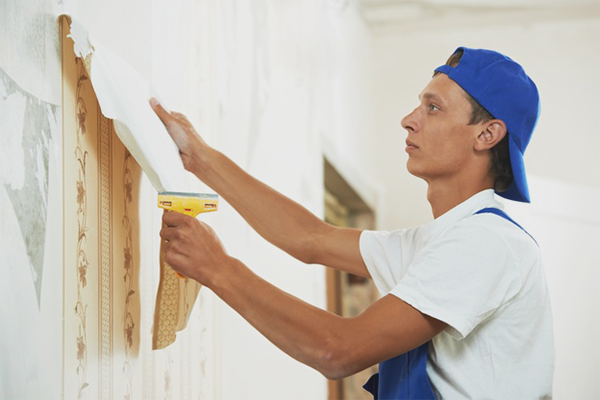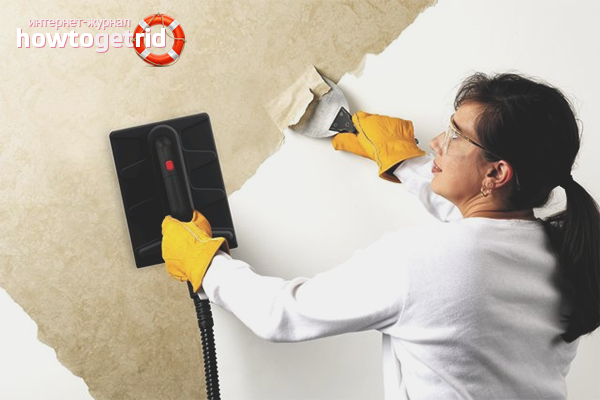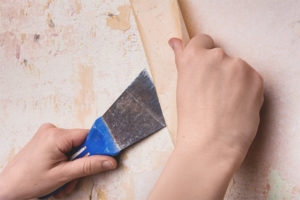The content of the article
Classic paper and washable vinyl wallpaper fit into any interior. Finishing material is inexpensive and looks good on the walls and ceiling. Fills the rooms with comfort and creates a unique atmosphere. But when it comes time to update the repair, the wallpaper makes the apartment owners nervous. Both paper and vinyl varieties are firmly glued to plaster or concrete surfaces. How to save time and quickly clean the walls?
Preparatory stage
It is impossible to remove the finishing material without dust and loose plaster. Furniture from the premises in which it will be renovated is transferred to vacant rooms or exposed to a balcony. Massive cabinets, sofas and other items are shifted to the center and covered with plastic wrap.The floor is covered with old newspapers, and baseboards are stuck with a wide building tape.
It is desirable to de-energize the apartment. Under the wallpaper hiding electrical wires that just touch the spatula or wet, triggering a short circuit.
Do not do without a stable stepladder, comfortable old shoes and clothes that you do not mind soiling. Useful drill with grinding nozzle, sandpaper, a bucket of warm water and glue packaging.
Spatula and kitchen knife
With a finishing coating that is more than 6–7 years old, tools with a sharp blade will cope. Old wallpapers are independently separated from the walls due to dampness and time. You need to find the swollen areas, pry off the peeled paper with a kitchen knife or the edge of a spatula, and then slowly pull. Paper types become shabby, therefore it is impossible to pull them sharply. Pieces stuck in the plaster, hooked with a wide spatula. Islands that could not be separated from the base are treated with water or a grinder.
Vinyl and non-woven options to remove easier. The canvas with a water-repellent coating is cut in the middle and hooked edge with a spatula.Hands pull the bottom half, then remove the top, and the remnants of the paper base brush off with a stiff bristle brush.
Caution: Do not rub the plaster or concrete wall too intensively, especially in old houses and apartments. The material crumbles and disappears, there are holes and dents. We have to spend extra time and money on priming and leveling the walls under the new wallpaper.
Water treatment
Fresh finishing cloth, which is up to 4–5 years old, is pre-soaked. Liquid dissolves glue and softens the paper, protects the plaster from damage. Warm or hot water will do.
Wallpaper with a water-repellent coating is treated with a roller with sharp spikes. If in the house there is no such tool, the usual knife is useful. With a sharp blade make wide cuts around the perimeter. The larger the holes, the easier it is for the fluid to seep through the paper.
With wall-paper which ordinary water could not soften, special solutions will cope. Cloth, pasted on the wall using PVA, treated with soap. A bar of detergent crushed, poured into the pan. Pour 3-4 liters of water and, while stirring, bring to a boil.In a hot billet moistened roller or foam sponge. The finishing material is soaked with liquid and wait 20 minutes for the soap to work.
Water-repellent cloths are impregnated with a solution prepared from a fabric softener. 200–300 ml of a chemical component is added to a bucket of liquid. The concentration is increased if there are several layers of finishing material on the wall.
Construction glue and PVA will dissolve table vinegar. Connect a bucket of hot water and 400 ml of product. Chips from commercial soap are added to the mixture, if the plaster crumbles heavily, and the wallpaper literally ate into the base.
The solution is applied to 1.5-2 square meters. m. of finishing material. It is impossible to process the whole room at once, because part of the room will dry out, and it will be necessary to repeat the impregnation in order to clean the walls from the wallpaper. Water softens the paper base of the rolls in 20 minutes, the solutions work twice as fast.
The liquid is applied with a paint roller, soft cloth or a large foam sponge. Wallpaper in old houses sprayed with a spray gun so that less liquid gets on the walls. If you apply too much water, it can soften the plaster and putty.
Damped cloths are hooked with a wide blade trowel. The remaining pieces are sprayed from a spray bottle and cleaned with emery paper with a water-repellent coating or a metal brush. Choose hard bristled varieties.
Remnants of wallpaper and plaster are immediately swept into a heap so as not to trample dirt on the floor. The walls treated with soap solution, it is desirable to wipe with a sponge dipped in clean warm water. Liquid removes residual powder and softener. Household chemicals absorbed into the concrete base and interacts with glue, deteriorating its properties. New wallpapers will not hold well, they can swell and fall away on the very first day.
Steam cleaning
High-quality glue, which could not be dissolved with water, is steamed with an iron. You will need a sheet or thin towel, a bucket of water and an assistant to hold the cloth:
- A rag is dipped into a container with liquid, unscrewed and applied to the wall, covering the pieces of finishing material.
- Iron turn on and set the maximum temperature.
- A hot device is used to iron the sheet several times.
- A rag is removed and quickly removed with a spatula the remnants of wallpaper.
The paper web is softened with a steam generator or steam cleaner. Domestic varieties will be useful in the household. Devices eliminate dirt from outerwear and upholstered furniture. Construction steam generators have limited functions, so this technique is purchased by repair professionals.
Steam cleaner to iron the wall, placing a clean, dry sheet under the device. If not to use a rag, dust and dirt which can provoke breakage get into the equipment.
Work with paper wallpaper easier. Stroked and removed. If you have to steam vinyl varieties or non-woven, it is recommended to first remove the water-repellent film, and then turn on the iron. Paper particles that could not be removed in this way are scraped off with coarse sandpaper or a spatula.
Hot steam penetrates the putty, so cleaned walls are dried for several days, and then primed and painted or pasted new wallpaper. If you apply a finishing material to a wet base, a mold will appear.
Special formulations
People who do not have time to scrape and steam, it is recommended to buy a tool for instant wallpaper removal. The product is sold in hardware stores. This is usually a powder or thick jelly that needs to be diluted with water. The most popular are Atlas Alpan and Quelyd Dissoucol.
In a solution prepared from the powder, the roller is moistened and the wallpaper is processed. On canvases with a water-repellent coating, small cuts are made. It will take the tool 2–3 hours to dissolve the glue and soften the paper layer. Wallpaper will begin to lag behind the concrete base. Cloths hooked with a spatula or with their hands and stripped off the wall.
Manufacturers claim that solvents are safe and do not emit toxic fumes, but it’s better to work with rubber gloves. To ensure that the tool does not fall on the open skin and mucous membranes.
Wallpapers, pasted in several layers, treated with a special solution. Not only powder, but also glue is added to the water, so that the mass becomes thick, like jelly. Such a tool is better absorbed and softens all paper bases.
Unusual options
Liquid wallpaper - one of the best inventions of mankind.Finishing material does not need to scrape and tear off. The walls are sprayed with hot water and wait 2 hours. Wallpapers gradually absorb moisture and swell. Some areas disappear on their own, others are easily removed with a wide spatula.
Glass fiber can not be removed without special washes. Finishing material is treated with the solution and left for several hours. When the canvas is swollen, armed with a spatula or a kitchen knife and scrub wallpaper from the walls. After the procedure, the concrete base is dried, plastered and ground.
Non-woven and vinyl wallpaper is not necessary to shoot completely. Rip off only the top layer with water-repellent properties. Paper bottom is left if the walls are smooth, without cracks and holes. Over old wallpapers paste new canvases.
Drywall
Concrete walls are not afraid of water and grinding machines. Plasterboard partitions covered with a paper layer. You can not remove it, otherwise you will have to throw away the old plates and buy a new finishing material.
Cheap construction glue will help to clean the plasterboard base from the wallpaper. Dilute several packs of powder with warm water.Stir to avoid lumps, and put a thick mass on paper or vinyl canvas. Leave on for 3-4 hours. The tool dries slowly, soaking into the wallpaper. They swell and soak, so they are easily separated from drywall.
Glue should be thick, so as not to spread throughout the wall. The solution is applied in a thin layer, otherwise it will be absorbed into the drywall. Sometimes a little primer is added to the blank. The tool will make the liquid to dissolve the wallpaper viscous. The mortar will dry more slowly, plus the primer will prepare the plasterboard walls for further repairs.
If in the closet are old wallpaper grandmother's time, rolls are not discarded. Cut the canvas and stick on the wall, treated with glue with a primer. Old wallpapers soften and stick to the top layer. You just need to pull the edge of the canvas, and the walls will be clean. Do not have to get a spatula and turn on the drill.
Key recommendations
Thin paper sheets that could not be peeled off with water and special solvents are cleaned with a drill. They put a brush with iron bristles on the tool and grind the concrete base. Irregularities remaining after removing the wallpaper, it is recommended to seal up with acrylic putty. It is inexpensive and high quality, suitable for leveling walls. The putty is applied with a stiff stainless steel trowel so that it lies flat on the base.
Plasterboard plates will have to be replaced if the wallpaper is glued with PVA. In this case, neither the solvent, nor the sharp spatula, nor the drill with the grinding nozzle will help.
Modern washable wallpaper is easy to stick and take off. You will need to tinker with old paper varieties, but solvent and sandpaper will solve the problem. The main thing is not to forget to dry and prime the walls after the removal of the finishing material so that the new wallpaper lays down well and serves more than one year.
Video: how to quickly and quickly remove old wallpaper






 7 votes, on average: 3,57 out of 5
7 votes, on average: 3,57 out of 5







To send